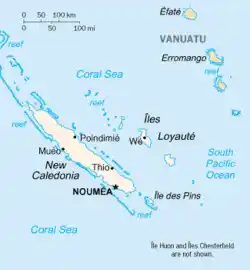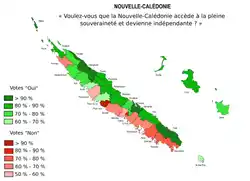
The New Caledonia independence movement is an independence movement which emerged in the French Pacific colony of New Caledonia in the aftermath of the Second World War. New Caledonia was established in 1853 as a colony of France. It became an overseas territory in 1946. Failure to decolonize led to the establishment of the Kanak and Socialist National Liberation Front in 1984 to pressure France into granting greater regional autonomy and then independence. A roadmap was agreed in stages in 1988 and 1998 whereby referenda would be held on independence after several decades of economic development. These plebiscites were rejected in 2018, 2020 and 2021, however the final referendum in 2021 was boycotted and judged unfair, particularly so within the context of the Covid-19 pandemic. These mounting issues resulted in widespread violence and unrest against French rule in 2024. Colonization and the independence movement have impacted on the demography of New Caledonia over time in different ways, though it remains a very thinly populated archipelago.[1]
Research your ancestors on MyHeritage
New Caledonia independence movement chronology of eventsNew Caledonia independence movement chronology of events

New Caledonia is an archipelago of islands in the Western Pacific Ocean which lies to the east of Queensland in north-eastern Australia, to the northwest of New Zealand and south of the Solomon Islands and Vanuatu. There are over 140 islands in the archipelago. However, some 90% of the entire land mass is made up of the central island, Grand Terre. The islands were first inhabited around three and a half thousand years ago. Owing to their geographical remoteness in the Pacific Ocean the islands were largely unknown to Europeans until the late eighteenth century. It was the famed British explorer, James Cook, on the second of his three epic voyages around the Pacific, who named the islands New Caledonia, as the landscape reminded him of Scotland, Caledonia being the old name for the north of Britain during the era of the Roman Empire.[2]
The French were rivals of the British to colonize parts of the south-western Pacific Ocean in the late eighteenth and nineteenth centuries. While the British emerged victorious in this race in Australia and New Zealand, the French did acquire control over much of the smaller island chains, including Grand Terre and the surrounding smaller islands. A formal colony was established here under the orders of Emperor Napoleon III in 1853. For many years it served as a penal colony, to which French convicts were shipped, much as had occurred in Australia with the British from the late 1780s onwards. French rule was not unopposed and when French colonists began arriving in the 1860s and 1870s to exploit the nickel mines that were just then being dug, the natives launched a guerilla war. As such, the Caledonian independence movement has a long history.[3]
French colonial activity on Grand Terre and the smaller islands of New Caledonia continued into the twentieth century, though the level of colonial settlement was always modest, in part because of the highly mountainous and unproductive nature of the land. Consider, for instance, that the population of New Caledonia today is not much more than quarter of a million people. This is despite Grand Terre being around 45% the size of Taiwan, an island with a population of 23 million people. The thinly inhabited archipelago expelled the Vichy officials who allied with the Axis Powers during the Second World War and then joined the Allies against the Germans and the Japanese. Yet despite the loyalty of New Caledonia in the war, in 1946 it was made an overseas territory as France attempted to shore up its crumbling colonial empire in the aftermath of the conflict.[4]
The New Caledonian independence movement has emerged gradually since the Second World War. It is led by the Kanak indigenous people, who make up about 40% of the population of some 270,000 people. The rest of the population is a mix of people of French descent and Polynesian heritage, as well as a substantial cohort of people of mixed ancestry. The Kanak and Socialist National Liberation Front was established in 1984 to pressure for increased regional autonomy and then independence from French colonial rule. Since their foundation they engaged in a mix of violent agitation, such as the Ouvéa cave hostage taking incident of April and May 1988, in which several French gendarmes were killed, and negotiations such as the Mantignon Agreements signed later that year.[5]

The Mantignon Agreements and the subsequent Nouméa Accords of 1998 set out a roadmap for increased French investment in New Caledonia with a view to it potentially remaining a French overseas territory, while also including provisions for the holding of an independence referendum to let the population there decide on the issue in several decades time. An independence referendum was finally held in 2018. It was rejected and nearly 57% of those who voted opted to remain part of France, with a turnout of more than 80%. A second referendum was then held in 2020, which was again rejected, though by a smaller margin. The agreements with France stipulated that just three referendums could be held on the matter. A third was held in quick succession in 2021, however it was boycotted by the Kanak and Socialist National Liberation Front and was overwhelmingly rejected with a turnout of just 44% in the midst of the Covid-19 pandemic.[6]
In May 2024 the New Caledonia independence movement made international headlines after violence erupted on Grand Terre concerning unhappiness with the manner in which the referendum had been held in 2021, ongoing French rule, economic issues such as the declining nickel-mining industry and a range of other social and political issues. The trigger for the unrest was a planned set of voting reforms. A state of emergency prevailed for several weeks and 14 people died in the violence. An estimated one billion euros of economic damage was also inflicted on the local economy. Eventually the immediate crisis passed, but the state of affairs remains tense in New Caledonia and the political crisis caused by the long-running independence movement is ongoing.[7]
Migratory and demographic impact of the independence movementMigratory and demographic impact of the independence movement

The New Caledonian independence movement and French rule on Grand Terre and the other islands more broadly has been associated with considerable migration. Thousands of French convicts and administrators arrived in the nineteenth century and these transformed the ethnic landscape of New Caledonia over time. Thus, there is a mixed demography here of indigenous Kanak people, a Melanesian group, Polynesians from other parts of Oceania and French people, as well as those with mixed heritage. Many people of French ancestry have left New Caledonia since the 1980s as the independence movement has intensified. They have often headed to France itself. Poor economic opportunities, some of which are related to the nature of French rule, have also driven Kanak people from their homeland. Many have migrated to Australia. Finally, the independence movement has been responsible for some internal migration and demographic shifts, as the capital, Nouméa, is where 70% of the population lives and has experienced especial unrest.[8]
See alsoSee also
Explore more about the New Caledonia independence movementExplore more about the New Caledonia independence movement
- New Caledonia: Towards Independence at Minority Rights Group
- New Caledonia: Six Questions to Understand the Current Crisis at Le Monde
- Macron in New Caledonia: why is the territory divided and will it break away from France? at The Guardian
- Fractures in New Caledonia's Independence Movement Widen, Uncertainty Reigns at The Diplomat
References
- ↑ https://www.lemonde.fr/en/les-decodeurs/article/2024/05/17/new-caledonia-six-questions-to-understand-the-current-crisis_6671770_8.html
- ↑ http://www.geography-site.co.uk/pages/countries/atlas/newcaledonia.html
- ↑ David Chappell, The Kanak Awakening: The Rise of Nationalism in New Caledonia (Honolulu, 2014), pp. 24–55.
- ↑ https://www.bbc.co.uk/news/world-asia-pacific-16740838
- ↑ S. K. N. Blay, ‘Self-Determination and the Crisis in New Caledonia: The Search for a Legitimate Self’, in Asian Survey, Vol. 28, No. 8 (August, 1988), pp. 863–880.
- ↑ https://forumsec.org/sites/default/files/2024-04/2021%20Forum%20Ministerial%20Committee%20to%20New%20Caledonia%20Referendum%20Observer%20Report.pdf
- ↑ https://thediplomat.com/2024/09/fractures-in-new-caledonias-independence-movement-widen-uncertainty-reigns/
- ↑ https://devpolicy.org/voting-with-their-feet-demographic-shifts-in-new-caledonia-20240801/

